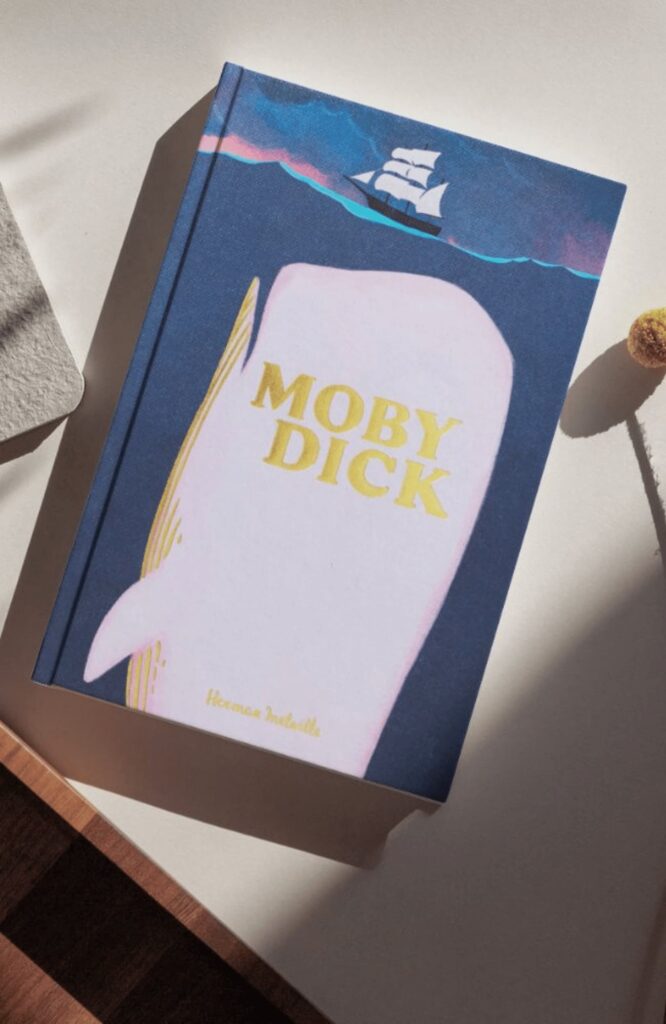![New Bedford / NB Whaling National Historic Park - 'Sperm Whaling - The Chase' by CF Wright [1885] Moby dick](https://wordsworth-editions.com/wp-content/uploads/2022/03/1998_MobyWeb.jpg)
Stephen Carver looks at Moby Dick – Part One
‘One of the strangest and most wonderful books in the world’: Moby-Dick; or, The Whale (1851)
In 1839, after a long chain of dead-end jobs necessitated by his outwardly prosperous but privately profligate father’s debt-ridden death seven years earlier, the 19-year-old Herman Melville did what many other disaffected and adventurous young men had done before him and ran away to sea. He signed aboard the merchantman St. Lawrence as a ship’s boy (the lowest ‘green hand’ rank), for a round trip from New York to the then vast trading port of Liverpool. Returning to New York in the autumn, he took a teaching position but left after one term because he never received any wages. After a trip up the Ohio River in an unsuccessful quest for employment and inspired by Richard Henry Dana’s nautical memoir Two Years Before the Mast (1840) and Jeremiah N. Reynolds’ 1839 article ‘Mocha Dick: Or The White Whale of the Pacific’ in the Knickerbocker magazine, Melville headed for New Bedford, Massachusetts, the ‘Whaling City’. There, he signed aboard the whaler Acushnet, again as a ‘green hand’, for a 1/175th share of the profits, setting sail at the beginning of January 1841.
It was the custom of whaling vessels to ‘gam’ if their paths crossed in the open ocean, meaning that the captains and first mates would meet for drinks and to share intelligence on the movements of whales, while the crews also got together and swapped stories. The Acushnet regularly gammed with the Lima from Nantucket, whose company included William Henry Chase, the son of Owen Chase, who had been the first mate on the whaler Essex, sunk by an abnormally large sperm whale approximately 2,000 nautical miles west of South America in 1820:
I turned around and saw him about one hundred rods directly ahead of us, coming down with twice his ordinary speed of around 24 knots, and it appeared with tenfold fury and vengeance in his aspect. The surf flew in all directions about him with the continual violent thrashing of his tail. His head about half out of the water, and in that way he came upon us, and again struck the ship.
Chase had survived the appalling aftermath of the wreck, when the ship’s 20-man crew had spent three months at sea in three leaky whaling boats, eventually resorting to cannibalism, with survivors drawing lots to see who would be sacrificed and who would kill them after the corpses of the men who died of exposure ran out. (In another macabre twist, one boat carrying three men became separated from the group. It was found years later washed up on Ducie Island, an uninhabited atoll in the Pitcairn Islands, the skeletons of the crew still onboard.) Chase wrote an account of the ill-fated voyage in 1821, Narrative of the Most Extraordinary and Distressing Shipwreck of the Whale-Ship Essex, after which he returned to sea for another 19 years. Despite a distinguished seafaring career which saw him captain first the whaler Winslow and then his own ship, the Charles Carrol, Chase was haunted by his experiences. He spent eight years in an asylum after retiring, and when he died in Nantucket in 1869, he was found to have been hiding food in his attic. William lent Melville a copy of his father’s book, of which he would later write: ‘The reading of this wondrous story upon the landless sea, & close to the very latitude of the shipwreck had a surprising effect upon me.’
In the summer of 1842, Melville and his shipmate Richard ‘Toby’ Greene jumped ship at Nuku Hiva Bay and spent several weeks living with the Typee natives. He left the island onboard the Australian whaler Lucy Ann, where he took part in a mutiny and was briefly incarcerated in the ‘Calabooza Beretanee’, the British jail in Tahiti, before escaping. He then spent a month as beachcomber (an ‘omoo’ in Tahitian), eventually crossing over to the island of Moorea in French Polynesia. He shipped out as a boat-steerer on the Nantucket whaler Charles and Henry and was put ashore at Hawaii in the spring of 1843. After kicking around Honolulu for the next six months, Melville enlisted in the U.S. Navy as an ordinary seaman aboard the frigate United States. He was discharged (honourably this time) at Boston in 1844, having just turned 25.
Back home in New York State, Melville regaled his family with his adventures and other sea stories picked up along the way. They urged him to write them down and the result was his first book, Typee: A Peep at Polynesian Life, published by John Murray in London and Wiley and Putnam in New York in 1846. As Earnest Hemingway later wrote, ‘Any man’s life told truly is a novel’ and Typee is a creative nonfiction in the manner of George Borrow’s Lavengro (1851). Falling somewhere between memoir and novel, Typee is an exotic account of Melville’s time on Nuku Hiva Island after deserting from the Acushnet, with the addition of anthropological and linguistic analysis based on secondary research. Typee was a controversial book but also a bestseller, establishing Melville as a significant literary presence on both sides of the Atlantic virtually overnight. Some critics doubted the veracity of the tale, until Toby Greene and the Acushnet’s captain, Valentine Pease, publicly corroborated the story, leading journalists to dub Melville the ‘man who lived among the cannibals’. Notably, and to the chagrin of several critics, Melville was apt to sympathise with the ‘cannibals’ while criticising European colonial interference and the introduction of Christian missionaries:
It may be asserted without fear of contradictions that in all the cases of outrages committed by Polynesians, Europeans have at some time or other been the aggressors, and that the cruel and bloodthirsty disposition of some of the islanders is mainly to be ascribed to the influence of such examples.
The voluptuous Indian, with every desire supplied, whom Providence has bountifully provided with all the sources of pure and natural enjoyment, and from whom are removed so many of the ills and pains of life—what has he to desire at the hands of Civilization? Will he be the happier? Let the once smiling and populous Hawaiian islands, with their now diseased, starving, and dying natives, answer the question. The missionaries may seek to disguise the matter as they will, but the facts are incontrovertible.
A sequel soon followed. Omoo: A Narrative of Adventures in the South Seas, was published by Murray in London and Harpers & Brothers in New York. The story picks up where Typee finished, with the unnamed narrator leaving Nuku Hiva aboard a whaler bound for Tahiti, leading to a largely autobiographical account of the mutiny and Melville’s subsequent imprisonment and escape. John Murray included both Typee and Omoo in his Home and Colonial Library, which was sold throughout the British Empire. Such global distribution cemented Melville’s reputation as a colourful travel writer with several generations of British Victorians, anticipating the south sea travelogues of Robert Louis Stevenson.
At this point in his literary career, the newly married Melville could have played it safe and banged out a series of crowd-pleasing nautical romances in the vein of Captain Marryat. Instead, his third book, the enigmatic Mardi, and a Voyage Thither (1849), resembles Melville’s previous adventure narratives only in the early chapters, before becoming a love story which then segues into an unfulfilled philosophical quest. The physical and spiritual journey of the first-person protagonist, Taji, first with his lover, Yillah, and then in pursuit of her, indicates the influence of both Swift and Rabelais as he travels from one fictional island to another, each representing different symbolic and satiric aspects of human society. (Melville was an autodidact, having been forced to leave school aged 12, and a voracious reader). Mardi was published in London by Dickens’ early publisher Richard Bentley, and Harper in New York. A transitional novel in many ways, in which Melville the storyteller wrestles with Melville the metaphysician, Mardi contains several themes that the author would explore and interrogate in almost everything he subsequently wrote: religious dogma, and the uneasy balance between a faith he did not entirely possess and the emptiness of absolute scepticism; the Romantic dichotomies of innocence and experience and good and evil; the apparent human impulse to destroy anything pure; the morality and delusion of ‘Democracy’; and a yearning search after some kind of ultimate truth which is always denied the seeker.
Mardi was Melville’s first commercial failure, with most reviewers finding it neither fish nor fowl, although it did attract favourable critical attention from Nathaniel Hawthorne, heralding a long friendship between the two writers, who saw in it ‘depths here and there that compel a man to swim for his life’. The influential journalist N. P. Willis also described the prose as ‘exquisite’. Melville followed-through with the more self-consciously mainstream Redburn: His First Voyage (1849) – once more published by Bentley and Harper – again drawing on his own experiences. Like Melville, his protagonist’s father dies a bankrupt, and the semi-autobiographical account of this period is raw and deeply moving. The main body of the novel is more happy-go-lucky in tone, recounting the adventures of Wellingborough Redburn (or ‘Buttons’), a well-mannered middle-class youth who must find his place among a ragtag crew of foul-mouthed and tough professional sailors on a voyage to Liverpool, mirroring Melville’s first taste of the seafaring life on the St. Lawrence in 1839. As he wrote to Bentley: ‘I have now in preparation a thing of a widely different cast from “Mardi”: – a plain, straightforward, amusing narrative of personal experience – the son of a gentleman on his first voyage to sea as a sailor – no metaphysics, no conic-sections, nothing but cakes & ale.’
Redburn was successful enough to warrant the similarly straightforward creative nonfiction White-Jacket; or, The World in a Man-of-War the following year (again published by Bentley in the UK and Harper in the US). White-Jacket is based on Melville’s time in the US Navy, an institution of which the book is unwaveringly critical, especially on the subject of flogging. (In this regard, it anticipates his final, uncompleted novel Billy Budd.) Critics and politicians alike picked up on this, horrified by the graphic descriptions of this brutal and arbitrary punishment, in part because Harper sent copies to every member of Congress. Led by the New Hampshire Democrat John P. Hale – who cited Melville’s novel – Congress banned flogging on all American ships in September 1850. White-Jacket was another popular success, but Melville later described it and Redburn as ‘two jobs which I have done for money – being forced to it as other men are to sawing wood.’ His problem was a familiar one to many writers, past and present: the tension between writing what he wanted to write (the metaphysics of Mardi), and what the market dictated (the nautical adventures). He thus set out to steer a path between both positions, in a new work he described to Bentley as ‘a romance of adventure, founded upon certain wild legends in the Southern Sperm Whale Fisheries, and illustrated by the author’s own personal experience, of two years & more, as a harpooneer…’
Like Leviathan, Moby-Dick was rising from the depths.
Stephen Carver
End of Part One
Image: ‘Sperm Whaling – The Chase’ by CF Wright [1885] Credit: Antony SOUTER / Alamy Stock Photo
Books associated with this article

Moby Dick (Collector’s Edition)
Herman Melville
